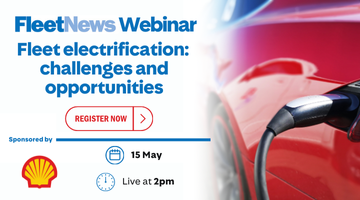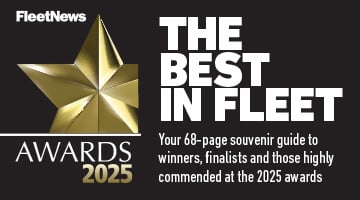Changes made to Managing Your Company Cars aim to make it more accessible than before
Picture the scene – it’s a glorious sunny day in Marbella, southern Spain, and there’s a shady spot under a palm tree with your name on it.
You sit down, grab a pen from your pocket and start writing.
But you’re not filling in a diary of your holiday or sending a postcard back home.
You’re writing about fleet management.
That was the beginnings of fleet consultant Colin Tourick’s first book Managing Your Company Cars.
It was ‘the beginnings’ because Colin didn’t get much of his book written during that holiday.
He found that there was just too much to write about.
So instead he set to work on a list of all the topics the book needed to cover.
By the time he returned home he had more than 300 bullet points.
During the next few months those bullet points turned into chapters and eventually the bible of the fleet industry was created.
The entire print run sold out and three years later the second edition was published, providing an update on the tax rules.
Copies sold in 26 countries, across six continents.
The success of Managing Your Company Cars still comes as a pleasant surprise to Colin.
He considers himself an ‘accidental author’.
He didn’t expect the book to be sold as far afield as Australia, India and Japan.
But Colin had hit upon a gap in the market.
“Fleet is a complicated industry,” he says.
“And it didn’t have a textbook. There was space in the market for a book like Managing Your Company Cars.”
Colin’s latest offering (published last month) is Managing Your Company Cars in Nine Easy Steps – a shorter version of Managing Your Company Cars.
“It’s meant to be something a fleet manager can read in three hours,” Colin explains.
“Managing Your Company Cars is a big book – 520 pages – and for a busy fleet manager it takes quite a time to read.
I’ve taken the core material from it and distilled it into a much slimmer volume.”
Inevitably, by producing a ‘quick read’ there are things which Colin has left out.
He has deliberately avoided a chapter on tax in order to prolong the book’s shelf-life and he has left out issues that would be relevant only to UK-based readers.
Colin points out that Managing Your Company Cars in Nine Easy Steps is not meant to be a replacement for Managing Your Company Cars.
Its purpose is to be more accessible, and its cheaper price tag reflects that.
“Managing Your Company Cars is priced at £60 so a fleet manager would probably rely on their employer buying it,” Colin explains.
“Managing Your Company Cars in Nine Easy Steps retails at £15.
"So I’m hoping that a fleet manager will be able to buy it themselves if their employer doesn’t.”
Colin is passionate about training and has served as chairman of the British Vehicle Rental and Leasing Association’s training committee.
He hopes that his books add to any training courses that fleet managers go on.
“I hope that fleet managers will use my books as a reference source,” he says.
“I want to find ways to encourage people to stay in the fleet industry longer.”
Colin himself has been involved in the fleet industry for more than 25 years.
His fleet career began as an accountant with LeasePlan UK in 1980 and for six years he was managing director of CitiCapital Fleet.
His CV also includes general manager of Fleet Motor Management, director of Commercial Union Vehicle Finance and corporate finance director of BNP Paribas’ leasing subsidiary.
In 2002, Colin turned his hand to consultancy, setting up Colin Tourick and Associates.
"I’d learned a lot of things while I was in the leasing and fleet management market and I realised my knowledge and skills might be of value to organisations,” Colin explains.
“I thought consultancy work would be more fun than working for one organisation – and it is. I enjoy the variety and it also means that I can stay out of the corporate politics.
"I can step in, do a good job and step away.”
The firm works with contract hire and leasing companies as well as fleet managers.
“We can help a fleet manager reduce costs, or reduce risks, or run their fleet more efficiently. Or all three,” Colin says.
But what about penning another fleet management book – does Colin have anything in the pipeline?
“I’ve got at least three other books in mind,” he says.
“I like the Managing Your Company Cars title. Perhaps my next book could be Managing Your Company Cars: Internationally.
"I also need to write a third edition of my ‘big book’ (Managing Your Company Cars). The only problem is finding the time.”
Special offer
Managing Your Company Cars in Nine Easy Steps retails at £15 but Fleet News readers can receive a discount.
Log on to www.tourick.com and enter promotional code 1598 to purchase the book for £12.
To get a taste of Managing Your Company Car in Nine Easy Steps see our exclusive extract from the book, below.
Decide your fleet policy
In the first of a regular series, Colin Tourick shares advice from his book Managing Your Company Cars in Nine Easy Steps
At a glance
- Put your fleet policy in writing and give a copy to each driver.
- Make sure your vehicles are fit for purpose.
- Set an allocation policy – who gets what car. Vehicles may be allocated by staff grade or you may allow employees to choose their own.
- You can publish a fixed list of the vehicles available.
- If cost reduction is important to you, the fleet policy should reflect this.
Step 1: Decide your fleet policy
‘Fleet policy’ is a fleet industry expression.
It means all of your organisation’s policies for running its car fleet, including the vehicles your drivers can choose, whether they may contribute extra to get a better car, how you manage driver safety and vehicle damage, and so on.
Your fleet policy should be set out in writing as a company car policy and should be handed to each driver.
Vehicle selection
Every vehicle your company uses should be fit for the tasks it will be required to do.
If it is to be used by a sales engineer to carry heavy loads, the maximum load weight, carrying capacity and sill height will be important.
If the sales manager will regularly use it for long-distance motorway driving, a larger engine and longer wheelbase will make his journey more comfortable and safer.
You need to consider the type of fuel, number of doors and whether the vehicle transmission needs to be manual or automatic.
If you allow staff to select extras, be aware that some enhance resale values while others do not.
For example, leather seating will enhance value in high-value cars but not in basic models.
Allocation policy
Next you need to set an allocation policy – deciding who gets what. While most organisations allocate vehicles according to staff grade, many allow employees to choose vehicles that meet private as well as business needs.
Such flexibility is good for staff morale but if you offer too much flexibility the costs can begin to rise.
A good approach to vehicle allocation is to select a benchmark car for each group of drivers (sales representatives, middle management, directors, etc) and build your list from there.
You should use wholelife costs rather than list price to determine the price band for each group, as this includes all the costs of using the car over the period including depreciation, interest, servicing, maintenance and repairs.
Fuel costs can be added if the company pays for fuel.
You can obtain wholelife cost data from magazines, fleet management and contract hire companies, motoring organisations and specialist publishers.
If used cars are allocated, the policy should specify how long they will be kept.
You can publish a fixed list showing all of the vehicles available for each grade of driver.
A fixed list gives you certainty and control.
Fewer anomalies will arise and your staff will easily understand the system, though if you change the list infrequently the business will bear the increased cost if car prices rise.
On the other hand, if you change the list frequently a vehicle available to a group of drivers one day will be unavailable to them the next day if a price rise has put the car out of their range.
Alternatively you can let the driver choose any vehicle.
This can cause problems when the driver leaves and you discover the car is not suitable to allocate to any other employee. This problem does not arise with a fixed list.
Cost-reduction strategies
If cost reduction is very important to you, your fleet policy should reflect this. There are many ways to reduce your fleet costs.
For employers:
- Don’t provide free fuel for private mileage.
- Choose the right financial product.
- Move to a fixed list not a user-chooser policy.
- Use wholelife costs to select vehicles for your fleet list.
- Make sure cars are serviced regularly to maintain fuel efficiency and to identify problems before they become expensive.
- Consider hiring cars rather than paying employees a mileage allowance to use their own cars.
- Consider running pool cars.
- Negotiate the best possible early termination clause in your contract hire agreement and avoid early termination charges by redeploying leased vehicles.
- Renegotiate contract hire agreements mid- term rather than building up big excess mileage charges.
- If you have a large fleet, consider self- insuring the comprehensive risk.
- Consider introducing a cash-for-car or ECO scheme.
- Use journey-planning tools.
For employees:
- Consider taking a cash option if it is offered.
- Choose a low CO2 vehicle, perhaps a diesel.
- Consider giving up free private fuel.
The article here is an abridged version from Managing Your Company Cars in Nine Easy Steps, published by Eyelevel Books in association with Daimler Fleet Management.
















Login to comment
Comments
No comments have been made yet.